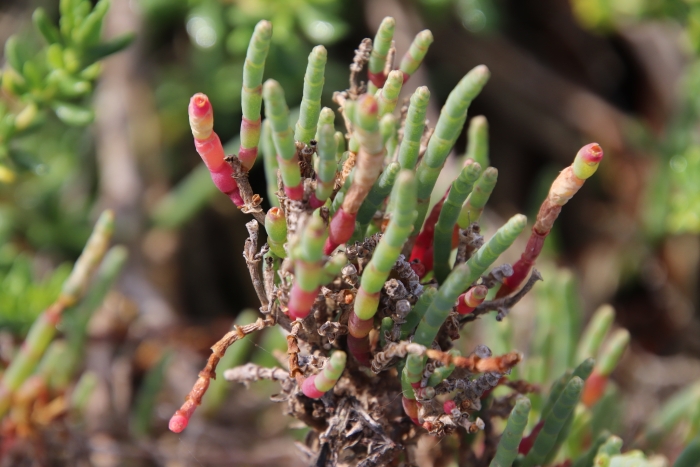Pacific Pickleweed
(Salicornia pacifica)
Pacific Pickleweed (Salicornia pacifica)
/
/

Millie Basden
CC BY 4.0
Image By:
Millie Basden
Recorded By:
Copyright:
CC BY 4.0
Copyright Notice:
Photo by: Millie Basden | License Type: CC BY 4.0 | License URL: http://creativecommons.org/licenses/by/4.0/ | Rights Holder: Millie Basden | Publisher: iNaturalist | Date Created: 2021-04-06T09:13:43-07:00 |























Estimated Native Range
Summary
Salicornia pacifica, commonly known as Pacific pickleweed or sea asparagus, is a perennial succulent halophyte native to salt marshes and mudflats along the Pacific and Atlantic coasts of North America. It typically forms dense, ground-hugging mats reaching heights of 4 to 16 inches (10 to 40 cm). Pacific pickleweed has jointed, succulent stems that are bright green, turning red or purple in the fall. It flowers from July to November with inconspicuous green blooms that are less noticeable than the vibrant stem coloration. The plant’s ability to excrete salt through its leaves allows it to thrive in saline environments.
Pacific pickleweed is valued for its ecological role in coastal habitats, providing cover and food for wildlife, including the endangered salt marsh harvest mouse. It is also harvested for human consumption, appreciated as a salty vegetable and sometimes used in gourmet cuisine. In cultivation, it requires a saline or brackish water source to maintain its health and characteristic flavor. While not commonly grown in traditional gardens, it can be a unique addition to saltwater aquariums or coastal restoration projects. Care should be taken as it can become invasive outside its native range.CC BY-SA 4.0
Pacific pickleweed is valued for its ecological role in coastal habitats, providing cover and food for wildlife, including the endangered salt marsh harvest mouse. It is also harvested for human consumption, appreciated as a salty vegetable and sometimes used in gourmet cuisine. In cultivation, it requires a saline or brackish water source to maintain its health and characteristic flavor. While not commonly grown in traditional gardens, it can be a unique addition to saltwater aquariums or coastal restoration projects. Care should be taken as it can become invasive outside its native range.CC BY-SA 4.0
Plant Description
- Plant Type: Shrub, Succulent
- Height: 0.5-2 feet
- Width: 0.5-1.5 feet
- Growth Rate: Moderate
- Flower Color: Green, Yellow
- Flowering Season: Summer, Fall
- Leaf Retention: Evergreen
Growth Requirements
- Sun: Full Sun
- Water: High, Aquatic
- Drainage: Slow, Standing
Common Uses
Edible*Disclaimer: Easyscape's listed plant edibility is for informational use. Always verify the safety and proper identification of any plant before consumption., Erosion Control, Low Maintenance, Salt Tolerant, Water Garden
Natural Habitat
native to salt marshes and mudflats along the Pacific and Atlantic coasts of North America
Other Names
Common Names: Pickleweed, Sea Asparagus, Pacific Glasswort, Pacific Samphire
Scientific Names: , Salicornia pacifica, Sarcocornia pacifica,
GBIF Accepted Name: